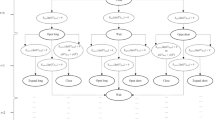Abstract.
To study the effectiveness of the Tobin tax, we develop a model of heterogeneous interacting agents. Traders either speculate on the basis of technical or fundamental analysis, or abstain from the market, a decision which depends on profit considerations, as well as communication between agents. Simulations generate stylized facts such as unit roots in exchange rates, fat tails for returns, or volatility clustering. The imposition of a Tobin tax leads to a crowding out of speculators and stabilizes the dynamics. However, the decreasing impact of fundamentalists triggers misalignments if tax rates are too high.
Similar content being viewed by others
Author information
Authors and Affiliations
Additional information
RID="*"
ID="*" Presented at the Economic Dynamics Workshop, Leiden, June 2002, and at the Computational Economics and Finance Workshop, Eltville, October 2002. I thank the participants for helpful discussions, especially Carl Chiarella, Cars Hommes, Seppo Honkapohja, Alan Kirman, Thomas Lux, Stefan Reitz, and Didier Sornette. I also thank two anonymous referees for their constructive comments.
Rights and permissions
About this article
Cite this article
Westerhoff, F. Heterogeneous traders and the Tobin tax. J Evol Econ 13, 53–70 (2003). https://doi.org/10.1007/s00191-003-0140-5
Issue Date:
DOI: https://doi.org/10.1007/s00191-003-0140-5




